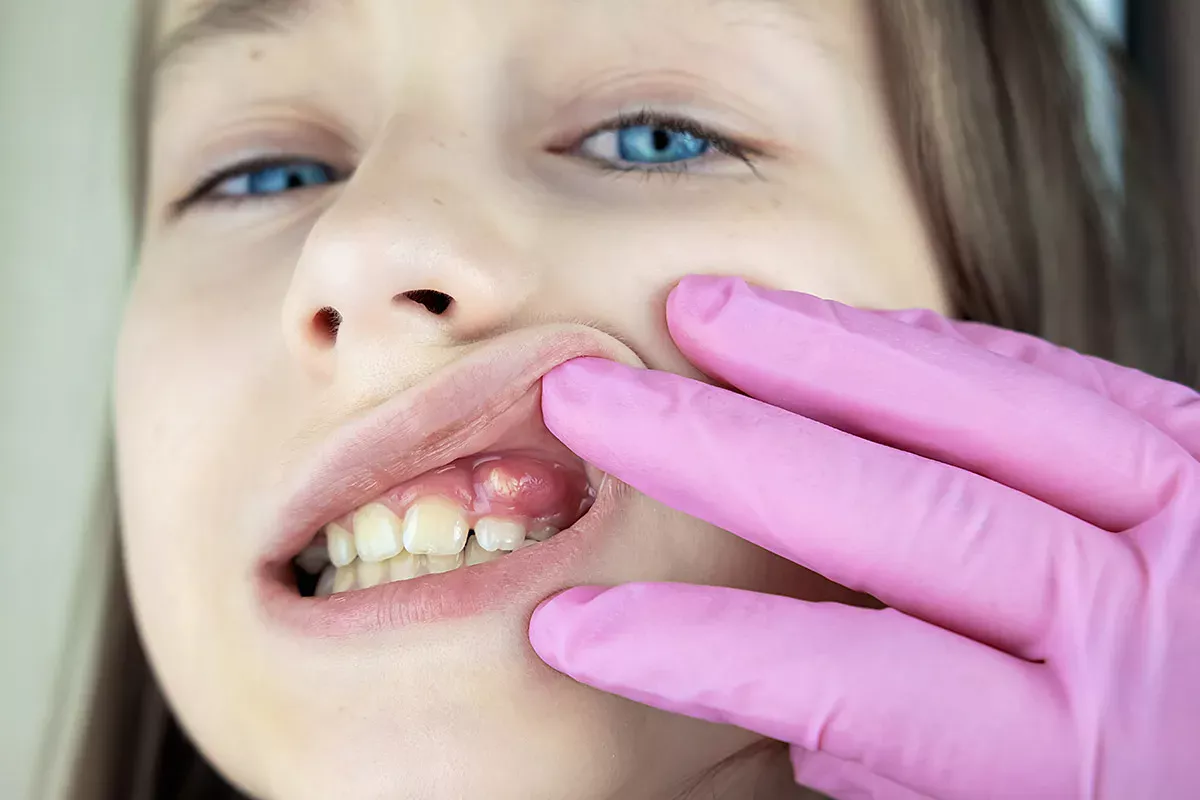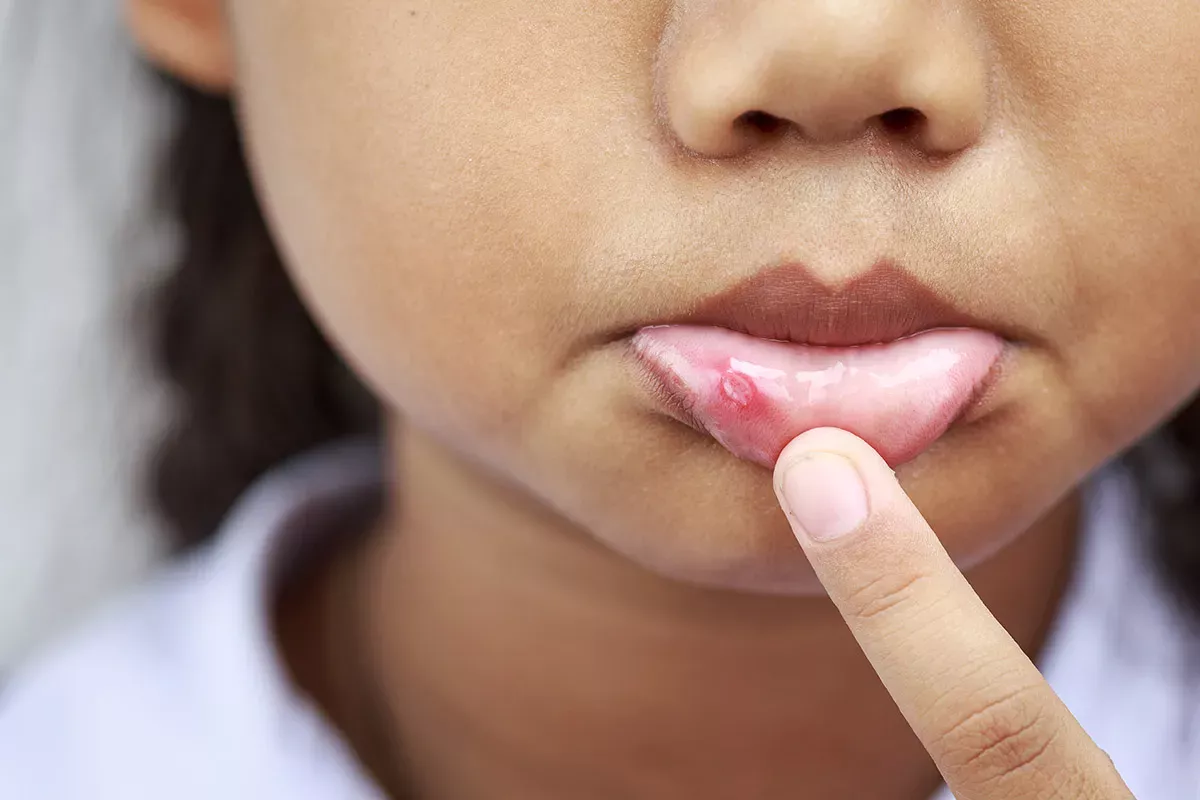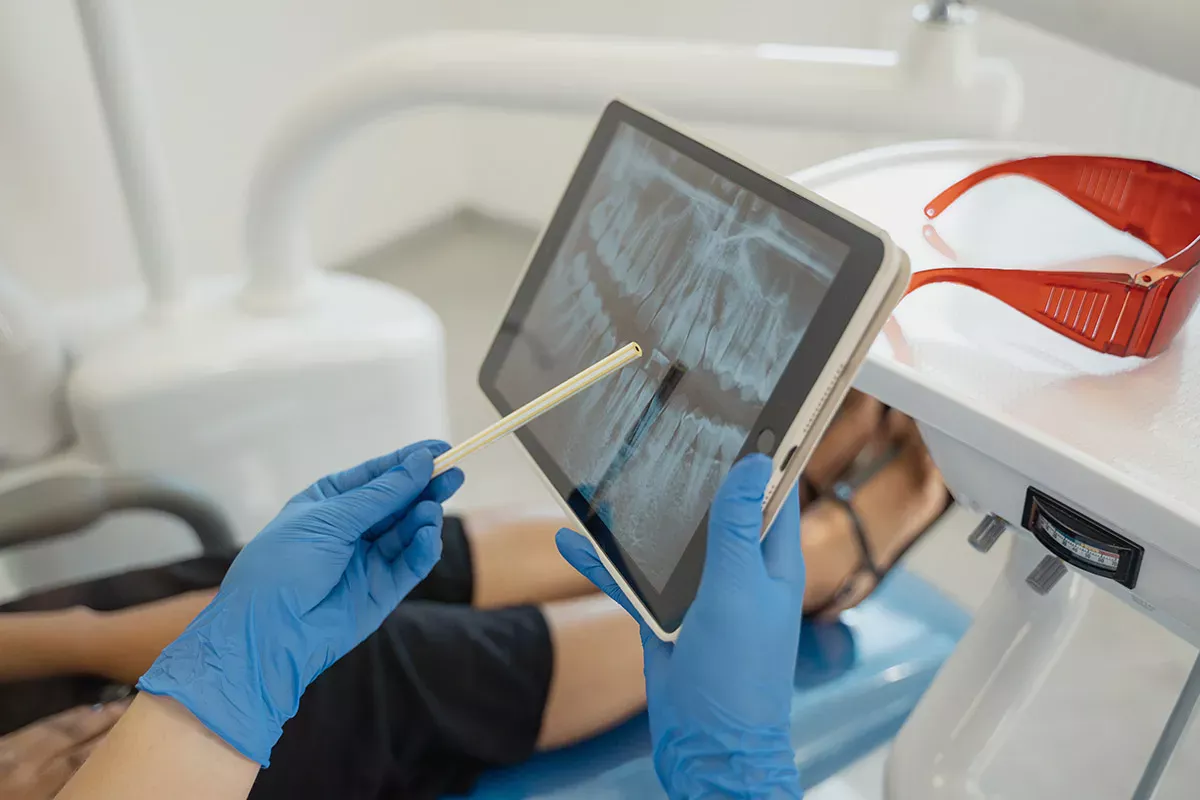Key facts in short
- Definition: A dental fistula is an abnormal "pathway" between an infected tooth root and the oral cavity.
- Symptoms: At the onset, there is mild swelling and reddening of the gums. Over time, the dental fistula fills with pus, leading to a persistent throbbing pain. If there is a build-up of pressure, the pus leaks into the oral cavity. Left untreated, the inflammation caused by the dental fistula can spread to the jawbone.
- Causes: Dental fistulas arise from an inflammation of the tooth root that extends to the surrounding tissues and then continues to progress. Certain risk factors promote the development of dental fistulas.
- Diagnosis: A dentist examines the gums, carries out a cold test and takes an X-ray image. Based on the findings, the dentist can determine whether the jawbones have already been impacted or changed.
- Treatment: Typically, the dentist prescribes antibiotics to kill the bacteria responsible for the inflammation. This may be followed by a surgical procedure, involving the dentist using a scalpel to open the dental fistula. If necessary, a diseased root tip must be removed or the entire tooth extracted. Never attempt to open a dental fistula yourself!
- Preventative measures: Thoroughly brushing your teeth regularly can help prevent inflammation triggered by bacterial accumulation in plaque. If you go for routine dental check-ups, your dentist can detect any issues early on and administer timely treatment. Maintaining a healthy lifestyle is also important.
Definition: What is a dental fistula?
A dental fistula is an abnormal channel that transports fluids, such as pus, from an area of inflammation to the exterior. The principle is similar to how a drain works. Dental fistulas usually emerge from bacterial inflammation affecting a tooth or its root, more precisely at the root tip. A dental fistula in the oral cavity looks like a pus-filled blister – much like a pustule or yellowish, inflamed spot. Dental fistulas can form in both the upper and the lower jaw.
What is the difference between dental fistulas, aphthae and abscesses?
Despite their visual resemblance to dental fistulas, aphthae have an entirely different underlying cause: Aphthae manifest when the immune system is disturbed by some external factor and reacts abnormally, causing tissue in the oral mucosa to die. Many things can trigger this response, including stress, a compromised immune system due to illness or an injury. Further, the whitish-yellow spots in the centre are not pus but simply discolourations. Aphthae typically resolve on their own after a few weeks without the need for treatment.
Abscesses, just like dental fistulas, are caused by bacterial inflammation in the gum tissue. However, unlike dental fistulas, abscesses form enclosed pockets where the pus accumulates without a direct outlet to the oral cavity, thereby preventing drainage. Surgical intervention is thus necessary to drain an abscess. Both dental fistulas and abscesses can, if left untreated, result in jawbone inflammation and eventually tooth loss – this is not the case with aphthae.
While aphthae and abscesses may also appear on the palate, inside the cheeks or on the tongue, dental fistulas typically develop exclusively on the gums – usually positioned directly above or below a tooth or an implant. Dental fistulas can also form underneath crowns.
The following images clearly show the difference between a dental fistula, an aphtha and an abscess:
Symptoms: How to recognise a dental fistula
Initially, a dental fistula forms without causing immediate pain or discomfort. At the outset, the affected area swells up. The gums are reddened, and there is a sensation of tightness around the tooth. Subsequently, a blister develops on the gum above or below the affected tooth, gradually filling with pus over time. As the dental fistula progresses, it starts to throb and cause pain. Swelling on the affected side of your face and a headache can occur as the condition worsens. This progression can extend over a period of several weeks. When significant pus accumulation creates excessive pressure, the dental fistula will burst, thus releasing the accumulated pus into the oral cavity. This alleviates the pain.
But beware! This does not mean that the dental fistula has resolved or vanished entirely. Since the inflammation is still present, the cycle starts all over again: The dental fistula fills with pus until it bursts. Permanent removal of a dental fistula requires intervention and treatment by a dentist.
Where can fistulas be found in the mouth?
Dental fistulas form exclusively on the gums. However, there are also oral fistulas, which are found predominantly on the lips, floor of the mouth, palate and maxillary sinus and which also stem from bacterial infections. Fistulas within the nasal cavity are called oronasal fistulas.
Good to know:
Fistulas are not only found in the mouth. They can form anywhere in or on the human body, including the genital area and intestines.
Consequences: What happens if a dental fistula is left untreated?
If a dental fistula is recognised in good time, it can be treated effectively. However, if left unattended over an extended period, a dental fistula can pose serious health risks and complications. Unfortunately, some individuals only go to the dentist after they have had a dental fistula for years, thus raising the risk of severe complications: The inflammation can extend to the jawbone, ultimately resulting in tooth loss.
In the worst case, a dental fistula can potentially impact the entire body: If the dental fistula becomes encapsulated and evolves into an abscess, there is a real risk of blood poisoning. Although this is rather uncommon, it is, nevertheless, extremely dangerous: If the abscess is also left untreated, the pathogens from the pus can spread throughout the body via the bloodstream, potentially leading to the failure of critical organs like the heart or kidneys.
Causes: What causes dental fistulas?
How exactly do dental fistulas form? And who is most at risk? Let us take a closer look at this below:
Main cause: Bacterial infection
The most common trigger for the development of dental fistulas is bacterial inflammation of the tooth root – especially of the root tip. This type of infection can arise when bacteria penetrate a tooth root, often stemming from dental decay or cavities. If this inflammation extends to the surrounding tissue, i.e. the gums, and is left untreated, a dental fistula develops, which gradually fills with pus.
Gingivitis, or inflammation of the gums, can also cause dental fistulas. These conditions can occur if you fail to brush your teeth thoroughly and do not remove plaque often enough. Bacteria then accumulate along the gum line and attack the gums with their harmful metabolites. Periodontitis, an inflammation of the periodontium, is the advanced stage of gingivitis where not only the gums but also the jawbones are impacted. The gums recede and gum pockets develop between the gums and the teeth, creating an ideal breeding ground for bacteria.
Risk factors: What promotes the development of dental fistulas?
Certain risk factors can increase the likelihood of oral cavity inflammation, ultimately triggering the development of a dental fistula.
Poor oral hygiene
Individuals who rarely brush their teeth or do so without the diligence and thoroughness required face an elevated risk of dental fistulas due to a heightened likelihood of experiencing dental decay, periodontitis and related conditions. Find out in the section on preventative measures how to care for your teeth effectively in order to prevent dental fistulas.
Dental fistula due to stress
Stress and psychological strain impact the entire body and can compromise the immune system's effectiveness. So, heightened stress levels at work or in your personal life make you particularly susceptible to illnesses of all kinds.
Smoking
Smokers are up to seven times more likely to develop periodontitis than those who do not use tobacco. So, it comes as little surprise that smokers suffer from dental fistulas more frequently. Smoking reduces the volume of blood being supplied to the entire oral cavity, thus making it harder for harmful substances to be eliminated.
Diet
Bacteria just love sugar. This is why a high-sugar diet can significantly fuel inflammation. Meaning: The more sugar you consume, the faster inflammation can spread. Adopting a low-sugar diet rich in anti-inflammatory phytonutrients can, therefore, be an effective strategy to combat inflammation.
Injuries in the oral cavity
Dental procedures that result in wounds, such as root canal treatments, apicoectomies or tooth extractions, can prompt gum inflammation that may eventually lead to dental fistulas.
Good to know:
Using a mouthwash containing chlorhexidine before and after oral surgery can help safeguard against bacterial infections. Chlorhexidine, the gold standard for eliminating oral germs, effectively kills all bacteria and ensures a well balanced oral flora.
A huge bonus of the mouthwashes of the Curaprox Perio plus series: The active ingredient Citrox® – a natural extract from bitter oranges – further enhances the antibacterial efficacy of chlorhexidine.
Weakened immune system and underlying health conditions
A compromised immune system provides favourable conditions for bacteria to thrive. Individuals with diabetes or asthma have an elevated risk of developing dental fistulas. This also applies to individuals who have undergone a stem cell transplant or chemotherapy, such as treatments for laryngeal cancer. Individuals struggling with alcohol addiction are also at risk of suffering from dental fistulas.
Who is at risk?
Dental fistulas can affect individuals of any age. They develop not only in adults but also in children with milk teeth. As their teeth and jaws are not yet fully developed, dental fistulas are actually even more common in children. Treatment is the same for children and adults alike.
Diagnosis: When should you consult a health care professional?
Unfortunately, many individuals with a dental fistula put off going to the dentist for treatment. The symptoms might not seem severe to start with. And seeing as the fistula periodically leaks and the pain subsides, many individuals decide there is no need for immediate action. However, we highly recommend seeking immediate help as soon as you experience any unusual gum swelling to determine the underlying cause.
During the examination, the dentist will thoroughly inspect your mouth for any signs of swelling, redness, injuries and any other abnormalities present on the gums. The dentist then performs a cold test to assess the tooth root or nerve, determining whether it is fully functional or has already died. If the tooth is still healthy, the patient perceives the cold as unpleasant and reacts accordingly. However, if the nerve of the tooth is already dead, patients will not experience any sensation in response to the cold stimulus.
Following that, an X-ray image of the jaw is taken, allowing the dentist to ascertain whether the jawbones have been impacted by the inflammation and to pinpoint the exact location of the inflammation. If needed, the dentist will refer you to an oral surgeon.
Good to know:
If your dentist discovers a dental fistula during pregnancy, managing the condition can become more complex. Since X-ray images should be avoided during pregnancy, your dentist will not be able to assess the full extent of the dental fistula. Based on experiences shared by pregnant women in online forums, treatment for a dental fistula is frequently deferred until after giving birth due to concerns regarding X-ray usage during pregnancy.
Treatment: How do you get rid of a dental fistula?
Treatment recommendations for a dental fistula can vary based on its stage of advancement and severity. But before taking a closer look at the treatment methods, we first want to answer an important question:
Can you burst dental fistulas yourself?
No! Under no circumstances should you attempt to do this. A dental fistula is not some small spot that you can simply squeeze and then everything is fine again. A dental fistula is a genuine dental issue that can lead to serious complications if mishandled or treated incorrectly.
Attempting to squeeze or lance a fistula yourself entails the risk of exacerbating the inflammation and negatively impacting the healing process. The discharged pus contains lots of bacteria that can easily spread throughout your mouth. Instead, have a dentist open the dental fistula using the appropriate equipment, thereby allowing the pus to drain away.
Treatment of dental fistulas
The treatment of dental fistulas varies from person to person and should be determined by your dentist based on your individual circumstances. This is the typical course of treatment:
Medications
If you are diagnosed with a dental fistula, your dentist will usually prescribe antibiotics to kill the bacteria causing the inflammation. The type and dose of the antibiotics obviously depend on the extent and severity of the dental fistula.
If the inflammation is clearly confined and the cause has been eliminated, your dentist might opt not to prescribe antibiotics for the dental fistula, instead recommending the use of an antibacterial mouthwash. Make sure to follow your dentist's instructions exactly.
Good to know:
If you are in severe pain and need to manage it while waiting for your appointment, over-the-counter painkillers containing ibuprofen can be helpful. These painkillers have anti-inflammatory properties. However, always remember to inform your dentist about all the medicines along with the doses that you have been taking before the examination.
Dental fistula surgery
In some cases, antibiotic therapy alone might be sufficient to cure a dental fistula. In many cases, however, the dentist has to perform a minor incision with a scalpel under local anaesthetic to open the dental fistula. During this procedure, the dentist directly extracts the pus, thus preventing the bacteria from spreading further.
The dentist also uses an X-ray image to determine whether additional measures are required: If the dental fistula resulted from inflammation at the root tip, the focus of inflammation can be eliminated through an apicoectomy to prevent any further spread – either through laser treatment or a traditional surgical procedure. Unfortunately, in some cases, the inflammation is so far advanced that the tooth has to be extracted.
Regular check-ups
After surgery, it is important that your dentist monitors the healing process. This way, it can be ensured there are no complications or recurrence of inflammation directly after the procedure. Even after completing the treatment, it is important to keep a close eye on the affected area and schedule regular check-ups with your dentist. Because dental fistulas may recur. If that is the case, the treatment has to start all over again.
Are there home remedies against dental fistulas?
Home remedies are not effective against the cause of dental fistulas, which is inflammation in the tooth root. Only dental treatment helps. Therefore, attempting to treat a dental fistula yourself is not advisable.
However, you can, of course, use home remedies for yourself or your child alongside dental treatment to help alleviate the symptoms. Some individuals, for example, swear by mouthwashes with cooled camomile tea. Clove oil and tea tree oil are also often cited as home remedies that can assist in alleviating the symptoms associated with dental fistulas. Rinsing your mouth multiple times a day with warm water mixed with two to three drops of oil can be helpful. The essential oils are said to have an anti-inflammatory effect.
Garlic and onions have antibacterial, antimicrobial and anti-inflammatory properties. Slicing them into small pieces and applying them to the affected area for a few minutes can allow their beneficial properties to take effect. If you find the onion or garlic flavour too intense, you can simply incorporate these vegetables more frequently into the food you cook.
But beware: Please consult with your dentist to determine whether these home remedies are suitable as a supplement to your dental treatment.
Is there alternative treatment for dental fistulas?
Homoeopathic remedies like globules and Schuessler salts can be used as supplementary measures alongside dental treatment. However, while they can complement treatment, homoeopathic remedies can never substitute surgical procedures or antibiotics. It is best to discuss the use of homoeopathic remedies with your dentist.
Note: There is no scientific evidence available that homoeopathic remedies actually work. According to expert assessments, like those from the Helmholtz-Gemeinschaft Deutscher Forschungszentren, any positive effects are most likely down to a placebo effect.
Preventative measures: How to avoid the (re)development of dental fistulas
Fortunately, there are measures you can take on your own to prevent the development of dental fistulas. Find some useful tips to prevent the development of dental fistulas and to reduce the chances of reinfection below.
Thorough oral hygiene
The bacterial infections leading to dental fistulas typically arise from inadequate oral hygiene, where plaque is not removed regularly or thoroughly enough. Luckily, this is within your control: By prioritising thorough oral hygiene, you can prevent dental decay, gingivitis and periodontitis. But how should you do this exactly?
You can find out everything you need to know about daily oral care in our comprehensive instructions:
Brushing teeth correctly with a sonic toothbrush
Regular check-ups at the dentist
With oral inflammation, it is often the case that those affected do not immediately realise that something is wrong. Similar to dental fistulas, gingivitis and cavities might not cause immediate pain in their initial stages. It is, therefore, important to go and see a dentist regularly to promptly identify and treat inflammation and other oral issues before they escalate.
Treating gum inflammation, dental decay and periodontitis in good time helps prevent the formation of dental fistulas altogether. You should also take your child to the dentist at regular intervals to make sure that there are no dental fistulas or other dental problems lurking in the shadows.
Having your teeth cleaned professionally once or twice a year is highly recommended as well. Professional cleaning effectively removes tartar, the hardened form of dental plaque and a favourite breeding ground for bacteria.
Healthy lifestyle
As smokers have an increased risk of dental fistulas, now would be a particularly good time to quit smoking and adopt a healthier lifestyle. This also includes a healthy diet rich in anti-inflammatory foods like fruit and vegetables – especially ginger, turmeric, chilli, onions and garlic. Omega-3 fatty acids sourced from cold-water fish, nuts and seeds exhibit anti-inflammatory properties, too.
Moreover, you should limit your intake of sugar and "fast-acting" carbohydrates, like those found in white flour, as they can exacerbate inflammation. Exercise is also known for its anti-inflammatory effects and is an integral component of a healthy lifestyle.
Sources
Borchers, Ralf: Die bessere Wahl: Konventionell oder mit Laser?, at: zwp-online.info.
Cansiz, Erol et al.: Treatment of Oral Fistulas, in: A Textbook of Advanced Oral and Maxillofacial Surgery Volume 3. 2016.
Chouk, Chourouk et al.: Oral Cutaneous Fistula. StatPearls Publishing. 2023.
Dentlounge Zahnmedizin: Zahnfisteln: Ursachen, Symptome und Behandlungsmöglichkeiten.
Dentteam: Mundgesundheit für Schwangere.
Imai, PH et al.: Comparison of interdental brush to dental floss for reduction of clinical parameters of periodontal disease: a systematic review, in: Database of Abstracts of Reviews of Effects. 2012.
Heinrich, Christian: Wirkt Homöopathie wirklich?, at: helmholtz.de.
Mainzahn: Welche Antibiotika werden zur Behandlung von Zahninfektionen eingesetzt?
Parvini, Puria et al.: Surgical options in oroantral fistula management: a narrative review, in: International Journal of Implant Dentistry. 2018.
Probol, Britta: Entzündungen mit gesunder Ernährung lindern, at: ndr.de.
Schulz, Cindy: Fistel austrocknen: Diese Hausmittel können die Heilung unterstützen, at: praxistipps.focus.de.
Unterberger, Tanja: Zahnfistel, at: netdoktor.de
Zahnärztin Wojcik: Zahnwurzelentzündung.
All websites last accessed on 22 May 2023.
 Swiss premium oral care
Swiss premium oral care









